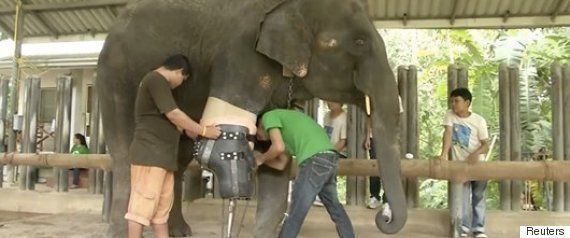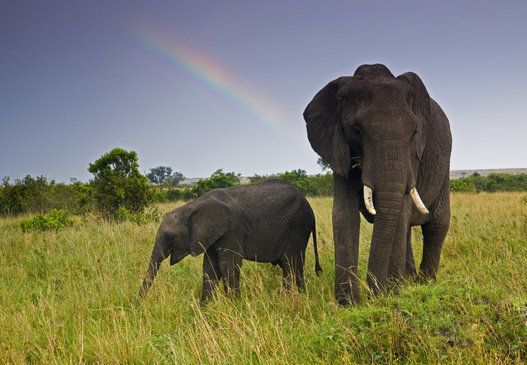
アジアゾウのグイダが、ラテンアメリカ初となる象保護区の自由エリアで草を食べる。
ブラジルの新しい象保護区は、2頭の老いたメスに新生活を提供している。
同じサーカスで40年過ごした2頭のアジアゾウ、マイアとグイダがこのブラジルの象保護区「エレファント・サンクチュアリ・ブラジル」で余生を過ごしている。この区域は、ラテンアメリカで初めての、囚われの身になっていた象のための保護区だ。

マイアとグイダが、自分たちの新しいすみかを探検する。
広さ2800エーカー(約1133万平方メートル)の施設は、ブラジル西部マットグロッソ州にある。2頭が保護区にやってきた10月11日、彼女たちが仲睦まじい様子で巨体を寄せ合い、お互いに優しく触れ合う動画が投稿された。
象の新しいすみかに関する非営利団体「グローバル・サンクチュアリ・フォー・エレファント」のスコット・ブレー代表は、「ここでの生活は順調です」と、CNNに語った。
マイアとグイダは、2頭とも40歳を超えている。彼らは生涯のほとんどを800マイル(約1300キロ)離れたブラジル・ミナスジェライス州のサーカスで過ごした。歳をとり、演技ができなくなった2頭は近くの農園に送られ、鎖に繋がれたままこの5年間を過ごした。グイダは、時にはチェーンを外されることがあったが、マイアは攻撃的だと思われ、過去にはグイダを押し倒したこともあったことから、チェーンを外すことは許されなかった。

マイアが、彼女の新しい家を歩き回る。
ブレー氏は「2頭が自分たちの新しい住処に到着して以来、2頭が敵意を見せるようことはありません」と話した。
「柵なしでお互いが出会った本当に最初の接触では、グイダは少し構えていて、少し身をかばう感じがありました。しかしその後は、ずっと一緒にやってきたように、ぴったり寄り添っています。50年来の親友という様子です」と、ブレー氏は言った。

アジアゾウのマイア(左)とグイダが、初めて自由エリアを歩き回る。
こうした成功例が、「エレファント・サンクチュアリ・ブラジル」でこれからも起こることが期待されている。AP通信によると、施設の職員は、南米に高齢で危険な状態の象が50頭以上いると推定している。象たちは生涯の大半を囚われた状態で生きてきており、老後を平穏に楽しめる場所が必要だという。
「エレファント・サンクチュアリ・ブラジル」は、古い牧牛場跡に建てられており、動物たちに獣医による医療と広大な熱帯の土地を提供することを目的としている。土地には、彼らが歩き回れる森林、牧草地、小川や泉がある。

グイダは新しく見つけた自由を楽しむ。
ブレー氏は、1995年にアメリカ・テネシー州で同様の保護区を共同設立した。AP通信によると、何十年も檻に収容されてきたゾウが、保護区のような管理された安全な環境でようやく自由を謳歌できるようになった時、彼らの本当の個性が表に出てくるのだという。

アジアゾウのグイダ(左)とマイア、新居の保護区で初めて並び立つ。
ブレー氏は、テネシー州の保護区にいたシッシーという名の象を例に挙げた。シッシーは反社会的というレッテルを貼られ、飼育係が彼女と接触してろっ骨を折ったことが原因で亡くなってからは「殺人ゾウ」と呼ばれた。シッシーは保護区でも、長生きするとは思われていなかった。しかし16年経った今も、彼女は元気だ。
「貼られていたレッテルはすべて、彼女の本来の姿ではなかったんです」とブレー氏は語った。「彼女を見ていくうちに、徐々に繊細で、心豊かなゾウへと成長したんです」
ハフィントンポストUS版より翻訳・加筆しました。
▼画像集が開きます
(スライドショーが見られない方はこちらへ)


【お知らせ】
ハフィントンポストでは、12月18日に働きかたに関するイベントを開催します。お申し込みは以下よりお願いします。
■イベント詳細と申し込み用フォームは下記リンクからもご確認いただけます。
